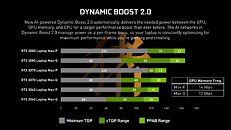Saturday, January 23rd 2021

NVIDIA to Drop Max-Q and Max-P Differentiators in Mobile GPU Specifications
NVIDIA has recently introduced its 3000 series of Ampere graphics cards designed for mobile/laptop devices. And usually, these GPUs in the past few years have been divided into two configurations: Max-P and Max-Q. The Max-P variant was a maximum performance configuration meant for more power usage and higher temperatures, representing a standard GPU configuration. The Max-Q design was, according to NVIDIA, "a system-wide approach to deliver high performance in thin and light gaming laptops. Every aspect of the laptop, chip, software, PCB design, power delivery, and thermals, are optimized for power and performance." Meaning that the Max-Q variants are more TGP limited compared to the Max-P configuration.
Update 23rd of January 11:35 UTC: NVIDIA spokesperson told Tom's Hardware that: "No, Max-Q branding is not going away. When we originally introduced Max-Q back in 2017, the brand was initially used in GPU naming since Max-Q referred to the GPU TGP only. Today, 3rd Generation Max-Q is broader, and is a holistic set of platform technologies and design approach to building powerful and thin laptops. In addition, to be more transparent about a laptop's exact capabilities, RTX 30 Series laptops now show more information than ever, listing exact TGP, clocks and features supported. You will find this in the control panel which now reports maximum power (TGP+Boost), and support for key features including Dynamic Boost 2, WhisperMode 2, Advanced Optimus, and others, all of which fall under the Max-Q umbrella. We strongly encourage OEMs to list clocks and other technologies a laptop supports, including Advanced Optimus, Dynamic Boost 2, and more. Ultimately, like all laptop features and specs, it is up to the OEM to market what their particular laptop configuration supports.)"
Today, according to Notebookcheck, NVIDIA has decided to drop these naming differentiators in the products, where customers are now unable to know whatever their product uses the high-TGP or low-TGP configuration of a specific GPU SKU.From now on, laptop makers will no longer list the GPU configuration in their specifications and will just list a GPU model, without any explanation whatever it is a Max-P or a Max-Q arrangement. Originally the company did announce both types of SKUs for the 3000 series GPU based laptops. However, this change has happened recently, and now when looking at the laptop specifications, the GPU variant is not listed. Below you can check out the slide posted on Chinese social media spotted by @9550pro on Twitter, showing the differences in Max-P and Max-Q offerings. Laptop OEMs have already excluded the Max-P specification from the specification list.
Sources:
Notebookcheck, via VideoCardz
Update 23rd of January 11:35 UTC: NVIDIA spokesperson told Tom's Hardware that: "No, Max-Q branding is not going away. When we originally introduced Max-Q back in 2017, the brand was initially used in GPU naming since Max-Q referred to the GPU TGP only. Today, 3rd Generation Max-Q is broader, and is a holistic set of platform technologies and design approach to building powerful and thin laptops. In addition, to be more transparent about a laptop's exact capabilities, RTX 30 Series laptops now show more information than ever, listing exact TGP, clocks and features supported. You will find this in the control panel which now reports maximum power (TGP+Boost), and support for key features including Dynamic Boost 2, WhisperMode 2, Advanced Optimus, and others, all of which fall under the Max-Q umbrella. We strongly encourage OEMs to list clocks and other technologies a laptop supports, including Advanced Optimus, Dynamic Boost 2, and more. Ultimately, like all laptop features and specs, it is up to the OEM to market what their particular laptop configuration supports.)"
Today, according to Notebookcheck, NVIDIA has decided to drop these naming differentiators in the products, where customers are now unable to know whatever their product uses the high-TGP or low-TGP configuration of a specific GPU SKU.


45 Comments on NVIDIA to Drop Max-Q and Max-P Differentiators in Mobile GPU Specifications
I do not even know what the good solution to this would be. Max-Q seemed like a good start but it didn't seem to end up useful for actually determining the performance level at glance. There are laptops with Max-Q GPU that runs as fast or faster than a crap laptop "Max-P" laptop. And there are Max-Q laptops that have minimum power limit and are very noticeably slow.
Obviously laptop OEMs request this kind of sliding scale of power limits which meanst the solution should to come from their side. But at the same time they are clearly not interested in clear specifications as we know. Some arm twisting from GPU OEM like Nvidia would be the other way but that isn't exactly a good thing either.
For example RTX 3070 90W or RTX 3080 80W... something like that
Though, it is in interest of NVIDIA to make sure actual performance is obsfucated, and customer ought to only rely on SKU name to determine relative performance.
I think I would just offer the one GPU per power target, with no configurable TGP. Say, you want a GPU that never goes beyond 115 W? Have a 3060. 125 W? 3070, and so on and so forth.
But, alas, that's probably not something Nvidia would care or want to do.
www.nvidia.com/en-eu/geforce/gaming-laptops/
- RTX 3060 Laptop: 60-115W
- RTX 3070 Laptop: 80-125W
- RTX 3080 Laptop: 80-150+W
3080 at 80W is faster than 3070 at 80W and probably matches 3070 at something like 100W.
This is not just an Nvidia thing either. AMD has "up to" values for mobile GPUs and no stated TDP/TGP/powerlimit, but a note that configurations will vary.
It's almost like nVidia give full authority for OEM and ODM to toying around with specs, but I say this could be harmful to customer. As an example I had notebook "L" and notebook "A" within same price range and I found out that one of them is performing not quite similar to the others. Fortunately , tiny app GPUz came to rescue and confirmed, both has spec as stated.
With MaxQ or MaxP annotations there's already alot of confussion, imagine when there's is none.
same to intel with they cpu naming...
But now we've regressed back to the old system. That's why I stated that I consider laptops garbage in a forum discussion few months back. You can't just say oh this lappy has i7 so it must be better than that i5 laptop. You don't know if the laptop has M.2 SATA ssd or NVMe one. RAM sticks are soldered or dual channel or not.
Laptop makers hold too much power over the configuration without disclosing it to the end-user.
But, great node. Seems like Nvidia's premium push is falling apart, Gsync, silently adapting a spec for HDR monitors, no Ampere GPU to be found so they sell you old Turing midrange, and laptop GPUs are back to a total smoke and mirrors event. Aaahhh the smell of progress.